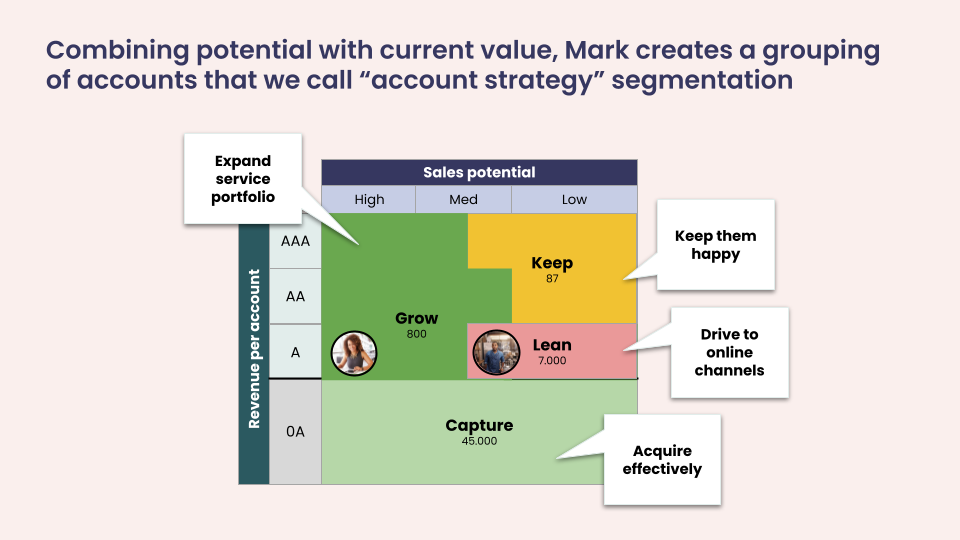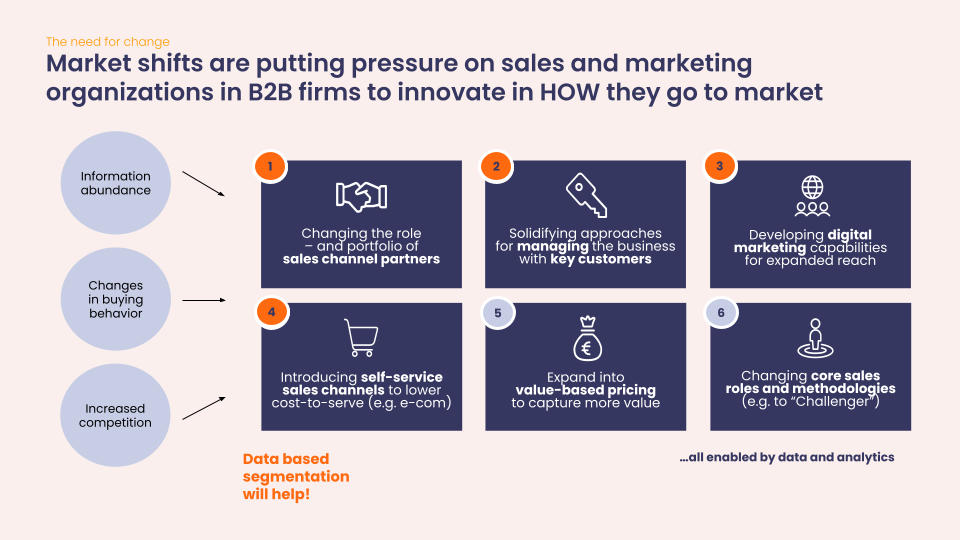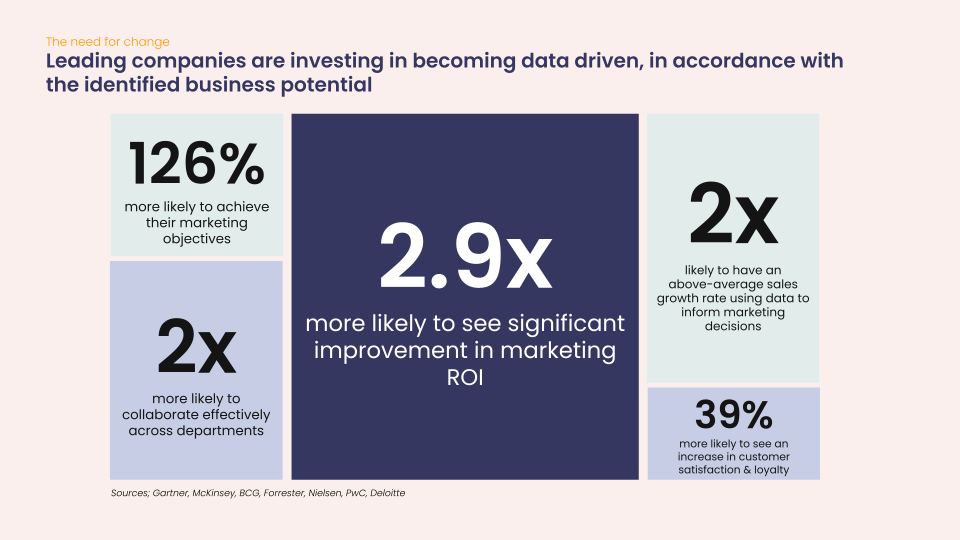Working in B2B, you need to understand your customers, and one way to do so is through effective segmentation to reach the right audiences with the right message. Most companies usually have vast data but fail to leverage it effectively. Creating solid segmentation models allows you to allocate resources more efficiently and improve sales and marketing performance. Here’s how segmentation can transform your business and drive measurable growth.
To deepen your understanding of B2B segmentation, watch our recent webinar on this topic, available on demand here. The webinar will also give practical tips based on a case story.
Why does segmentation matter?
Segmentation is basically the process of grouping customers or prospects based on shared characteristics. This helps you to target different groups with tailored marketing and sales strategies. In a B2B context, the primary goal of segmentation is to allocate resources to accounts with the highest value or growth potential, making your go-to-market strategy more focused and effective. Sounds brilliant, right?
Most B2B organizations already have a lot of customer data, but the challenge lies in how that data is structured and used. Often, customer information is scattered across different systems, such as CRM tools, ERP systems, and external platforms. Perhaps you recognize this in your organization? By consolidating this data into a unified view, you can create a more meaningful segmentation model that aligns with your business goals.
What are the benefits of data-driven segmentation?
As you know, the business landscape has shifted quite a lot in recent years. Today we see way more complex buying behaviors, larger stakeholder groups, and multiple channels through which customers engage with companies. These changes make it super important for B2B organizations to rethink their go-to-market strategies and invest in data-driven segmentation.
Companies that embrace this approach are more likely to see improvements in marketing ROI, better collaboration between marketing and sales teams, and increased customer satisfaction.
Effective segmentation allows businesses to:
- Prioritize high-value accounts: You can allocate your resources more effectively by focusing on customers or prospects with the highest lifetime value or growth potential, instead of wasting time and effort on the wrong accounts.
- Tailor marketing and sales efforts: Segmenting based on account needs ensures that your messaging is more relevant, increasing the likelihood of conversions and deeper engagement.
- Improve go-to-market efficiency: Data-driven segmentation helps streamline both marketing and sales efforts, resulting in faster sales cycles and better resource management.
How to create and use segments
Creating an effective segmentation model starts with gathering and structuring your data. Most companies will want to segment based on two main criteria: account value (how much revenue the account generates or could generate) and account needs (the specific requirements or pain points of the account).
Once the data is consolidated, it can be managed in a Customer Data Platform (CDP) or a Data Warehouse. Why is this crucial? Well, because ad-hoc tools like spreadsheets or CRMs are simply not designed to handle the complexity of modern segmentation needs.
Here’s how you can approach segmentation:
- Current value segmentation: Start by categorizing your accounts based on their current revenue levels. For example, you might create categories such as AAA (high-value accounts), AA (mid-tier), and A (low-value).
- Growth potential segmentation: Use analytics and AI to score each account’s potential for future growth. This will give you a clearer picture of where to invest more heavily in terms of resources.
- Account strategy segmentation: Combine current value and growth potential to develop a holistic account strategy. For instance, you might choose to focus on “Growth Accounts” for upsell opportunities, while pushing smaller “Lean Accounts” towards self-service channels to lower cost-to-serve.

Here’s an illustration from the case presented during the webinar, showing the segmentation model used to classify accounts based on their current value and growth potential, with categories like “Keep,” “Grow,” “Lean,” and “Capture.”
Don’t forget to leverage AI
AI can be particularly useful in segmentation, as it helps uncover patterns that might not be immediately obvious through traditional methods. For instance, AI models can predict the growth potential of an account based on a variety of factors such as company size, industry trends, and past purchasing behavior.
By combining AI-driven insights with historical data, businesses can create a more dynamic and responsive segmentation model. This not only allows for better resource allocation but also enables more personalized and relevant communication.
Activate segmentation across both marketing and sales
One of the biggest challenges in segmentation is ensuring that it’s actionable across both marketing and sales teams. For segmentation to work, the data needs to be available and integrated into the systems that both teams use daily, such as CRMs, marketing automation platforms, and customer service tools.
By ensuring that segments are available across these platforms, marketing and sales can work together more effectively. Marketing can tailor its campaigns based on the segmentation, while sales teams can focus their efforts on high-value accounts and those showing strong buying signals.
Practical outcomes of effective segmentation
When done right, segmentation can have a measurable impact on your bottom line. For example:
- Increased sales efficiency: Focusing on high-potential accounts leads to more effective sales efforts, reducing wasted time and increasing conversions.
- Lower acquisition costs: By targeting only those prospects with the highest likelihood of converting, businesses can reduce the cost of acquiring new customers.
- Better customer retention: Segmentation allows companies to tailor their offerings to meet the specific needs of each account, resulting in improved customer satisfaction and long-term retention.
7 key takeaways
Segmentation is not a one-time project but an ongoing process that evolves with your business and the market. By regularly reviewing and refining your segmentation model, you can stay ahead of industry trends, adapt to changing customer needs, and ensure that your go-to-market strategy remains efficient and effective. Companies that embrace data-driven segmentation will see increased collaboration across teams, better resource management, and, ultimately, stronger business growth.
Here are 7 learnings to take with you on your journey:
- Putting your data to work can significantly increase your go-to-market efficiency
- You likely need several segmentations for different needs
- Build your segmentation into the data layer and automate the segmentation to avoid ad-hoc work
- Start simple but think for the long-term
- Make the segmentation available in the systems used by sales AND marketing
- Collaborate with sales and other functions such as IT
- Build iteratively and revisit your segmentation model on an annual basis
Finally, 3 questions for you:
- Do you have a segmentation model, and is it incorporated into your business objectives?
- Do you truly understand your customers, customer segments, and their potential?
- Do you have the data and tools to activate and automate segmentation to increase marketing and sales effectiveness?
If these are questions you don’t have a clear yes answer to yet, please reach out, and let’s talk about what you need to do in order to get there!
Contact us
PS. If you want to hear the in-depth discussions and get into the details of B2B segmentation, make sure to watch the full webinar here.

